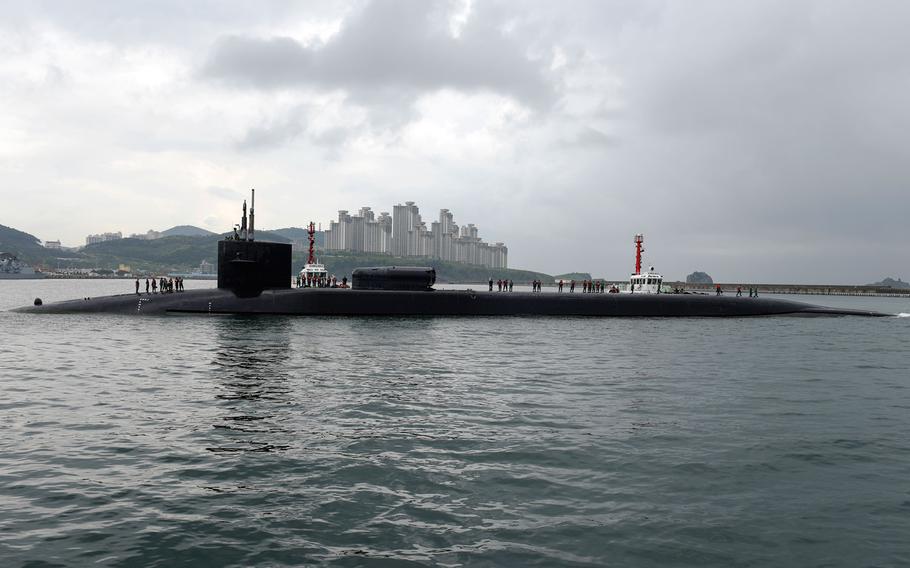
The Ohio-class guided-missile submarine USS Michigan (SSGN 727) arrives in Busan for a regularly scheduled port visit while conducting routine patrols throughout the Western Pacific. Michigan is the second submarine of the Ohio-class of ballistic missile submarines and guided missile submarines, and the third U.S. ship to bear the name. Michigan is home-ported in Bremerton, Wash. and is forwarded deployed from Guam. (Jermaine Ralliford/U.S. Navy photo)
SEOUL, South Korea — A U.S. guided-missile submarine made a port call in South Korea and the allied nations conducted maritime exercises Tuesday, while North Korea reportedly conducted a large artillery drill as tensions mounted on the divided peninsula.
The top U.S. commander in South Korea, meanwhile, warned the North that his troops were prepared for a fight.
“We’re ready, and we are committed to the [South Korea]-U.S. alliance," Gen. Vincent Brooks said in brief remarks to reporters after a ceremony at the Army’s Yongsan Garrison in Seoul.
The nuclear-powered USS Michigan — one of the world’s largest submarines — sailed into the southeastern port city of Busan. It was the latest show of force by President Donald Trump’s administration amid fears that the North will conduct another nuclear or missile test as it celebrated a series of important holidays this month.
The latest, the 85th anniversary of the founding of North Korea’s army, appeared to pass without such a test. But both sides showed off their military might as diplomats from Japan, South Korea and the United States met in Tokyo to discuss the growing threat from the communist state.
North Korea marked the day by staging an exercise involving some 300 or 400 long-range artillery pieces that have the range to target the South Korean capital, Seoul, or adjacent areas, the Yonhap news agency reported, citing an unidentified government source.
“Signs are detected that North Korea’s military is conducting a large-scale drill around the eastern port city of Wonsan on the anniversary,” the source told Yonhap.
South Korea’s Ministry of National Defense said it could not immediately confirm the report but was monitoring the North’s military movements in the area and “firmly maintaining readiness.”
North Koreans also laid flowers and paid respects at giant statues of former leaders Kim Il Sung and Kim Jong Il, the current leader’s grandfather and father respectively, according to The Associated Press.
Navy ships also held simultaneous bilateral maritime exercises with South Korea and Japan, the 7th Fleet said.
The USS Wayne E. Meyer, a guided-missile destroyer that is part of the Carl Vinson strike group, and South Korea’s Wanggeon participated in drills to the west of the peninsula. The USS Fitzgerald and the JS Chokai operated in the sea off Japan’s west coast, it said.
South Korea’s navy said it also planned to hold another major joint naval practice involving the USS Carl Vinson aircraft carrier in the sea off the peninsula’s east coast near the end of the month.
“The joint exercise is to show U.S. and South Korea’s strong will to retaliate and its firm defense posture against North Korea’s provocative threat,” it added.
The Navy said the port visit by the USS Michigan, which is more than 560 feet long and weighs more than 18,000 tons when submerged, was routine and part of a regularly scheduled deployment to the Western Pacific.
The submarine is equipped to carry as many as 154 Tomahawk missiles and more than 60 special operations forces. Its homeport is Bremerton, Wash., but it is forward deployed from Guam.
North Korea, which is known for its exaggerated and belligerent rhetoric, strongly objects to the deployment of such strategic assets to the divided peninsula. It has threatened to sink the USS Carl Vinson.
A senior North Korean military official blamed the U.S. and its allies for the spike in tensions, saying his country also is ready to use pre-emptive strikes and other measures.
“The conditions for an outbreak of nuclear war are being made on the Korean peninsula due to the frantic war games of the U.S. imperialists and their followers,” Gen. Pak Yong Sik said at a ceremony held on the eve of the army’s foundation day.
“If enemies dare to try a military adventure … our revolutionary power will wipe out the strongholds of aggression by using powerful nuclear attacks,” he added.
While insisting that all options including military action are on the table in dealing with North Korea, Trump’s moves so far have not been markedly different from the previous administration’s reliance on economic punishment and diplomatic pressure.
On Monday, Trump called on the U.N. Security Council to impose tougher sanctions against the North, saying the status quo is unacceptable and it’s “a problem that we have to finally solve.”
Stars and Stripes reporter Yoo Kyong Chang contributed to this report.gamel.kim@stripes.com Twitter: @kimgamel